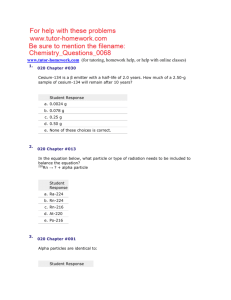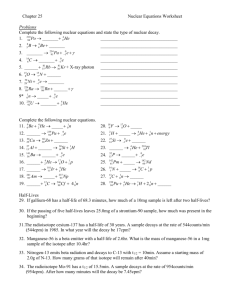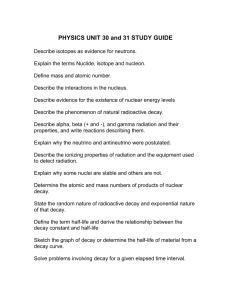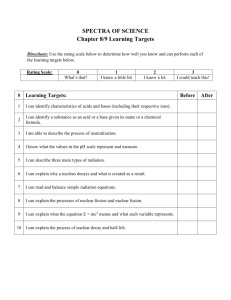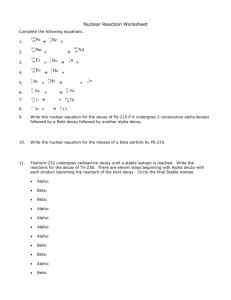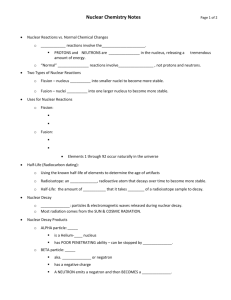Activity 1: Earth, Air, Fire or Water
advertisement
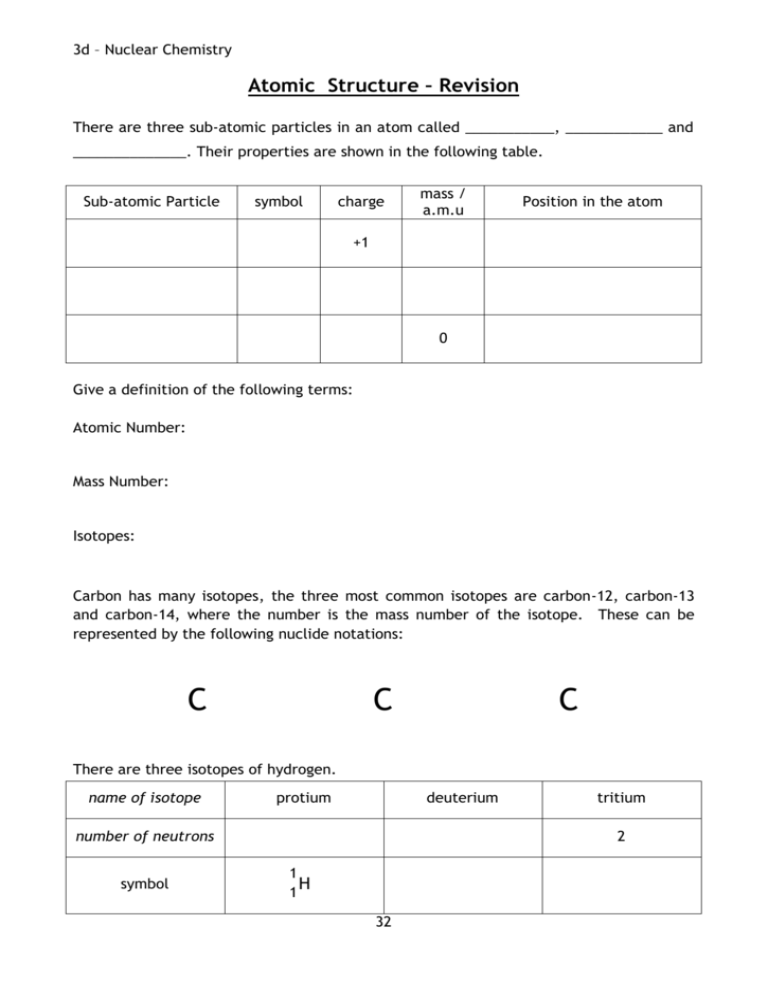
3d – Nuclear Chemistry Atomic Structure – Revision There are three sub-atomic particles in an atom called ___________, ____________ and ______________. Their properties are shown in the following table. Sub-atomic Particle symbol charge mass / a.m.u Position in the atom +1 0 Give a definition of the following terms: Atomic Number: Mass Number: Isotopes: Carbon has many isotopes, the three most common isotopes are carbon-12, carbon-13 and carbon-14, where the number is the mass number of the isotope. These can be represented by the following nuclide notations: C C C There are three isotopes of hydrogen. name of isotope protium deuterium number of neutrons symbol tritium 2 1 H 1 32 3d – Nuclear Chemistry Radioactivity Radioactivity was discovered by Henri Bequerel in 1896, when he found, quite by chance, that some uranium salts had ‘fogged’ a wrapped photographic plate. Since no light could have penetrated the wrapping, he concluded that the uranium salts were emitting an invisible radiation. This phenomenon was called radioactivity. Radioactivity happens when the nucleus of an isotope of an atom is unstable. These nuclei spontaneously disintegrate (decay) with the emission of radiation and the release of energy. This process continues until the nucleus becomes stable. This is quite unlike ordinary chemical reactions where the nuclei remain intact and only the outer electrons are involved in the chemical changes. The stability of an atom depends on the relative band of stability numbers of protons and _______________ in its nucleus. This diagram shows that a band of stability can n=p be plotted, when the number of protons is plotted against the number of ___________________ for all stable naturally occurring nuclei (each dot is a stable nucleus). The black line is a plot of when the number of protons and neutrons in the nucleus is equal. We can see that the lighter stable nuclei have approximately equal numbers of neutrons and protons but as the nuclei become heavier, the number of neutrons increases more rapidly than the number of ______________________ . Protons will _______________ each other in the nucleus and so as there are more protons present the ________________ are able to dampen this effect and stop the nucleus from flying apart. Nuclei which lie outside the stability band are unstable and therefore radioactive. They will disintegrate with the emission of radiation. until the unstable radioactive nuclei form ______________ nuclei, i.e. nuclei with neutron to proton ratios which lie inside the ________________ band. 33 3d – Nuclear Chemistry Types of Radiation There are three types of radiation - alpha (), beta () and gamma (). The particles that make up alpha radiation are helium nuclei, each containing two protons and two neutrons. The particles in beta radiation are electrons. Beta particles are formed in the nucleus when a neutron breaks up into protons and electrons. 1 n 0 1p 1 + 0e -1 As soon as they form, these high energy electrons are ejected from the nucleus as beta radiation. While alpha and beta radiations are made up of particles, gamma radiation consists of electromagnetic waves and therefore has no mass. The following diagram shows how the three different types of radiation are affected in by an electric field. As you can see from the above diagram, alpha particles are deflected in one direction by a small amount, beta particles in the other direction by a larger amount and gamma rays are not deflected at all. Suggest why each type of radiation behaves as it does in the presence of an electric field: 34 3d – Nuclear Chemistry Stopping Radiation Alpha, beta and gamma radiations have different abilities to pass through air and other materials. Paper Aluminium Lead Alpha radiation can only travel a few centimetres in air and can be stopped by a piece of paper. Beta radiation can travel a few meters in air and can be stopped by a thin piece of metals such as aluminium or lead. Gamma radiation can travel around one hundred metres in air and is stopped by a thick piece of lead. The most energetic type of radiation is The least energetic type of radiation is 35 3d – Nuclear Chemistry Nuclear Equations With the exception of gamma radiation, all nuclear activity involves particles from the nucleus. This means that we can use nuclide notation to represent nuclear equations. All nuclear equations must be balanced. This means that the total mass numbers and atomic numbers for the reactants and the products must be equal. Alpha Decay Alpha radiation is a helium nucleus containing two protons and two neutrons. 4 An alpha particle has the symbol 2He , As a result the mass number of the original isotope will go down by four and the atomic number by two. e.g. Thorium-232 decays by alpha emission to form Radium-228. 232 90Th → 228 88Ra + 4 2He Note the total mass number on each side is 232 and the total atomic number is 90. Beta Decay Beta radiation is an electron formed from the breaking down of a neutron, a proton is also formed. 0 A beta particle has the symbol -1 e , As a result the mass number will remain the same and the atomic number will increase by one. e.g.Radium-228 decays by beta emission to form Actinium-228. 228 88Ra → 228 89Ac + 0 -1e Note the total mass number on each side is 228 and the total atomic number is 88. Gamma Emission Gamma emission is energy, not a particle, and as such has no effect on either the mass number or atomic number. 36 3d – Nuclear Chemistry Summary: Type of emission Effect on mass number Symbol alpha Effect on atomic number decrease by 4 beta increase by 1 gamma no effect 1. Write a nuclear equation for a. alpha decay of polonium-210 b. beta decay of strontium-90 c. alpha decay of radium-226 2. Part of a radioactive decay series is shown below. 231 90Th decay → X → Y decay → 227 90Th a. Identify isotopes X and Y b. Which type of decay occurs between isotope X and isotope Y? 37 3d – Nuclear Chemistry Half-Life The radioactive activity of a radioactive isotope, or radioisotope, is measured by the number of nuclear decays which occur each second or minute. The half-life, t½, of a radioactive sample is the time taken for the radioactive activity, or the mass of a sample, to fall to half of its initial value. The half-life for an isotope is constant, no matter how much of the sample is left. This means that the time taken for 100 g to decay to 50 g is equal to the time taken for 10 g to decay to 5 g. The following graph shows the activity of an isotope over time. This is called a ‘decay curve’ and the shape will always be the same regardless of the isotope. From this graph the time taken for the activity to half is ________ days. This is the half-life, t½, of the isotope. Complete the table to show how the mass of radioactive phosphorus-32 changes over time. The half-life of phosphorus-32 is 14 days. Time (days) 0 14 28 42 56 70 84 98 Mass of phosphorus-32 (g) 32 38 3d – Nuclear Chemistry Draw a line graph of mass of phosphorus-32 versus time. The rate of decay depends only on the mass number of the radioisotope present. Different isotopes of the same element will have a different half-life e.g. fermium-252 has a half-life of one day and fermium-253 has a half-life of three days. Some isotopes have a very short half-life, e.g. radon-220, t½ = 55 seconds. Some isotopes have a very long half-life, e.g. uranium-238, t½ = 4.51 billion years. Unlike ordinary chemical reactions half-life is not affected by changes in temperature, pressure or by the presence of a catalyst. The half-life of an isotope is only reliant on its nucleus and so it is the same whether the isotope is an atom, an ion or a part of a compound. 39 3d – Nuclear Chemistry Half-life Calculations 1. A radioisotope of phosphorus has a half-life of 14 days. A sample of the radioisotope has a mass of 80 g. Calculate the remaining mass of the sample of the radioisotope after 56 days. Since one half-life is 14 days then 56 days is 56/14 = 4 half-lives Half-lives Mass 0 80g 1 40g 2 20g 3 10g 4 5g 2. The initial radioactivity of a sample of a radioisotope was 100 counts/minute. If the activity fell to 25 counts/minute in 24 days, what is the half-life of the radioisotope? Half-lives 0 Activity 100 counts/minute 1 50 counts/minute 2 25 counts/minute 25 counts/minute = two half-lives = 24 days t½ = 12 days 3. A radioisotope has a half-life of 7000 years. How long will it take for 48 g of the radioisotope to decay to leave 6 g? Half-lives 0 Mass 48g 1 24g 2 12g 3 6g t½ = 7000 3 half-lives = 3 x 7000 = 21 000 years 40 3d – Nuclear Chemistry 1. For each of the following pairs, state whether or not both species have the same half-life. a. 1 g Pb-212 and 100 g Pb-212 b. 1 g Pb-212 and 1 g Pb2+-212 c. 1 mole Pb-210 and 1 mole Pb-212 d. 1 mole lead-210 and 1 mole lead-210 oxide. 2. The initial radioactivity from a sample of actinium chloride is 120 counts/minute. If the half-life of actinium is 6 hours, how long will it take for the sample of the chloride to reach a reading of 15 counts/minute? 3. A radioisotope used in a hospital has a half-life of 1.5 hours. It has a count rate of 8000 counts per minute at 9am. a. What would the count rate be at 1.30pm on the same day? b. An aqueous solution of a compound containing the radioisotope was prepared. What effect would this have on the half-life? 4. Samples of radium oxide and radium sulphate both contain the same radioisotope. Why does a 1g sample of the oxide show a different intensity of radiation from the sulphate? 41 3d – Nuclear Chemistry Uses of Radioisotopes There are many uses of radioisotopes including Examining body tissues e.g. 132I is used to check the health of the kidneys. Sterilisation e.g. Gamma radiation can be used to sterilise food or medical equipment. Detecting flaws e.g. 60Co can be used to take X-ray images of welding. Smoke detectors e.g. A small piece of 243Am emits alpha particles at a receiver. Even a small amount of smoke blocks the alpha particles and the alarm sounds. Carbon-14 Dating 14C is a naturally occurring isotope of carbon with a half-life of 5700 years. 14C from the atmosphere, in CO2, is constantly incorporated into plants during photosynthesis. This makes its way into all animals when they eat plants. When an organism, plant or animal, dies it no longer takes in beta emission. 14 0 → 147N + 6C -1e 14C and the levels drop by The age of a sample from a tree or bone, for example, can be determined from the remaining 14C content using its half-life. Carbon-14 has a half-life of 5700 years. An analysis of charcoal from a wood fire shows that its 14C content is 25% that of living wood. How many years have passed since the wood for the fire was cut? 42 3d – Nuclear Chemistry Nuclear Power The energy released in a nuclear reaction can be used to produce electricity. They are a good alternative to fossil fuels as they produce no greenhouse gases or sulphur dioxide which can cause acid rain and they will last longer than fossil fuels. Also a nuclear power plant produces more energy per year than a power plant which burns fossil fuels. There are issues, however, with the long term storage of the waste and an increase in the background radiation. There is also the possibility of an accident which could be extremely dangerous such as the accidents in Chernobyl, Ukraine in 1986 and in Fukushima, Japan in 2011. 43 3e – Chemical Analysis Chemical Analysis Chemistry plays a huge role in the way in which we monitor the world around us. The information that chemists collect helps to shape the policies implemented by government. In the early 1950s London was badly affected by smog, a mixture of smoke and fog. Visibility was so low that buses and trains were cancelled and, despite only lasting four days, over four thousand people died as a result of breathing problems caused by the smog. This brought about the Clean Air Act which meant that more care had to be taken over pollution in cities. Similar laws are still in force today and chemists monitor pollution levels to ensure that laws are followed. Although modern analytical chemistry makes use of sensitive, computerised instruments, the basics of analytical chemistry come from traditional techniques many of which are still used today. The type of chemical analysis carried out would depend on the problem faced; there are two types of analysis depending on whether we are concerned with finding out if a certain chemical is present at all or if we want to measure how much of it is present. Qualitative analysis gives an indication of the presence or absence of particular atoms, ions or molecules in a sample. These simply tell us if a certain chemical is or is not present. Quantitative analysis is related to quantities, e.g. the mass or concentration of particular atoms, ions or molecules in a sample. Accurate measurements are taken and calculations carried out. Decide whether each of the following examples would be a qualitative or a quantitative piece of analysis. 1. Finding out if a solution is acidic using blue litmus. 2. Testing the pH of a solution with pH paper. 3. Titrating vinegar using sodium hydroxide. 4. Flame testing a salt to identify the metal ion present. 44 3e – Chemical Analysis Bromine is a chemical commonly used to carry out a qualitative test on hydrocarbons to find out if they are unsaturated. You are given unlabeled two bottles, each containing a hydrocarbon. The two hydrocarbons are H C H H H H H C C C C H H H H H H C H pent-1-ene and C H C C C H H H H pentan-1,3-diene. Describe how this qualitative test could be changed into a quantitative test to identify the two hydrocarbons. 45
